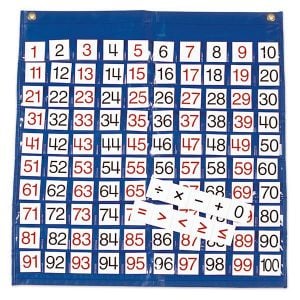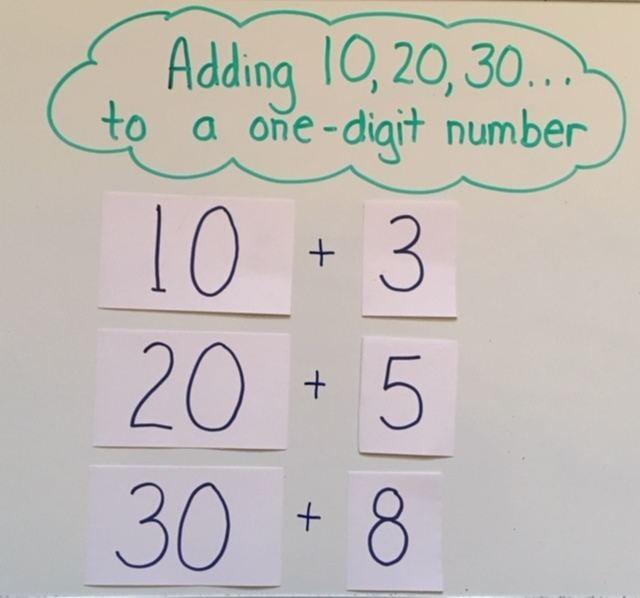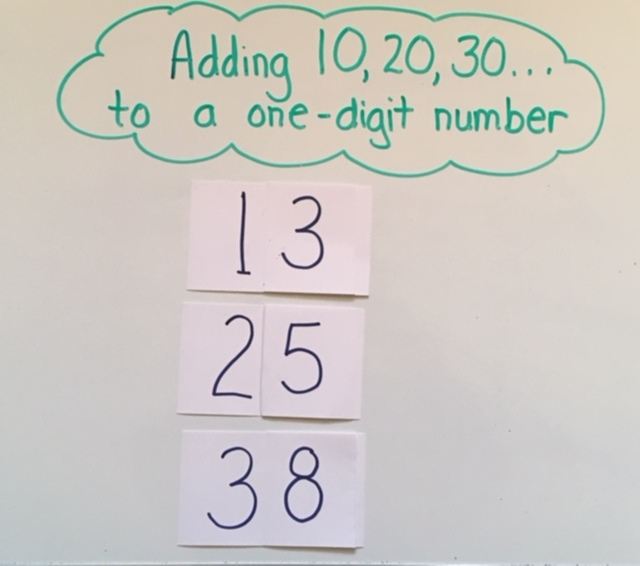by C. Elkins, OK Math and Reading Lady
I’m sure everyone would agree that learning the addition / subtraction facts associated with the number 10 are very important. Or maybe you are thinking, aren’t they all important? Why single out 10? My feelings are that of all the basic facts, being fluent with 10 and the combinations that make 10 enable the user to apply more mental math strategies, especially when adding and subtracting larger numbers. Here are a few of my favorite activities to promote ten-ness! Check out the card trick videos below – great way to get kids attention, practice math, and give them something to practice at home.
-
- Add or subtract 10 (or a multiple of 10):
- Examples: 10 + 4; 10 + 9; 20 + 5; 50 + 7; 38 – 10; 96 – 20
- Utilize tens and ones pieces for concrete examples.
- Show what happens to the one’s place when you add ones to a multiple of 10 (10 + 4).
- Step 1
- Cover the zero
Hold a card with “10” in one hand and another card such as “4” in the other hand. With the cards facing the students, slide the 4 over top of the zero in 10. The result of course is “14.” For some reason students really think of it as a cool trick. Be sure the one’s digit is written close to the left edge of the paper so when you slide it over the 0 in “10” it won’t cover up the ten’s place. Try the same thing with 20 + 4 and other combinations involving multiples of 10 combined with ones. Then students should be able to do it mentally.
- Use a 100 chart to add 10:
 Don’t immediately tell students that when adding 10, the number directly under it is the answer. Rather, start off at a random number such as 36. Show how to add 10 one at a time by moving to the right and using a return sweep to the next row. Notice where the answer is. Do this repeatedly until students start to notice that the answer is directly under the starting number.
Don’t immediately tell students that when adding 10, the number directly under it is the answer. Rather, start off at a random number such as 36. Show how to add 10 one at a time by moving to the right and using a return sweep to the next row. Notice where the answer is. Do this repeatedly until students start to notice that the answer is directly under the starting number. - Help students realize counting by 10 is not just 10, 20, 30, 40 . . . Isn’t 36, 46, 56, 66 . . . also counting by 10? Sure!
- Utilize these methods for subtraction also.
- Pairs of numbers that equal 10 (number bonds):
- Learn these via practice: 0 + 10, 1 + 9, 2 + 8, 3 + 7, 4 + 6, 5 + 5 and the commutative property of the first five listed. Knowing the number bonds helps with both addition and subtraction problems. If I know 2 and 8 go together to make 10, then I should know 2 + ___ = 10 and 10 -2 = ____.
- Shake and Spill: Shake 10 two-colored counters. If 2 come up red, then can the student determine the number of yellow without actually counting them? Do they know there are 8? With repetition, the goal is to predict how many of the second color by just counting the first color. Click here for the directions Shake and Spill Directions and a page to record the results: Shake and Spill recording page
- Fish for Ten: Grab this FREE: 4 Games About Ten. The directions for Fish for Ten and others below are included in this packet. This one is a variation of the traditional game of Fish. If Student A is holding a 2 in their hand, they should ask Student B for an 8 (because they make a ten match). If Student B has it, he gives it to Student A – who lays down the pair on the table. If not, Student B says, “Go Fish.” Then Student A draws another card from the stack.
- Tic-tac-ten:

Tic-Tac-Ten game
This is a tic-tac-toe game involving numbers. In this game, a student wins if he/she can complete 3 in a row using 3 numbers which combine for a total of 10. So this one is a little higher level thinking – but a lot of fun! Use a dice or number cube. Decide where to put the number rolled. Students each use a different colored crayon or marker to enter their numbers onto the grid. The strategic part comes when trying to determine the different scenarios possible depending on what you roll. (Get it via “4 Games About Ten” above.)
- Add or subtract 10 (or a multiple of 10):

